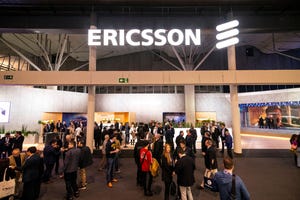CEO Chat With ZTE's Jane Chen
Light Reading CEO and founder Steve Saunders met up with ZTE's Jane Chen to talk about 5G, advanced cloud – and being a woman in comms.

A recent visit to Shenzhen afforded me the opportunity to meet with one of the most powerful women in the Chinese communications industry: Jane Chen, SVP and chief strategy officer at ZTE, at its impressive headquarters.
ZTE was kind enough to give Light Reading the full VIP treatment, including both compelling demonstrations of a variety of advanced technologies (everything from pre-5G, which it is already shipping, to advanced cloud, smart city, and optical solutions) as well as a frankly amazing Cantonese lunch.
I was hugely impressed by my experience at ZTE and was blown away by Chen's business technology philosophy, which, I think, comes through loud and clear in the following Q&A.
Enjoy the interview!
Figure 1:  ZTE's Jane Chen: "Everybody has their strategy. We follow our strategy."
ZTE's Jane Chen: "Everybody has their strategy. We follow our strategy."
Steve Saunders: How long have you been in charge of strategy for ZTE, Jane?
Jane Chen: One month.
SS: Really?
JC: Yes, but I've worked at ZTE for many, many years.
SS: How many years?
JC: I joined ZTE in 1988, and then went to America, to New York.
SS: Where were you working?
JC: I studied there, then after I graduated I worked at AT&T Bell for almost ten years. And then I came back to ZTE in 2002. I was in charge of wireless products R&D for more than ten years.
SS: What is the most important technology for ZTE moving forward? Is it mobile, is it optical?
JC: All of them. Mobile is definitely a key area; 2G, 3G, 4G, and the future definitely lies with 5G. On the network site, optical and access, and the backbone, which holds it all together. Then there's the terminal; this is also a major part of our business.
SS: For the consumer?
JC: Yes.
SS: What about virtualization, things like NFV, SDN, are they important to you?
JC: Yes of course. We're very active in this area, with lots of discussions with operators. A lot of great progress.
SS: When you talk to your carrier customers, where are they in the journey towards virtualization? Are they still thinking about it or do they want you to give them solutions which they can deploy this year?
JC: We already have some real virtualization products. The customers are there already. We allow our customers to construct the network that will support their future strategy today. I think that this is our biggest strength.
SS: In China or in other parts of the world?
JC: Both. But definitely in China. Telecom operators all over China are starting to do this. This is the year that I think virtualization is in mass production already.
SS: Really?
JC: In certain areas, yes, not everywhere, because right now the industry is still working on the standardization of virtualization.
SS: Some service providers who have tried to deploy NFV, like Telefonica, have had a difficult experience because they tried to put together a solution from many different companies, based on open source specs. And that was harder than they thought it was going to be. So now there's a trend amongst some service providers to say "we just want to buy from one company, because it’s safer. We don't want to buy from everybody and put it together ourselves." Do you think most service providers are going to want a pre-integrated or pre-certified solution from a single company as opposed to trying to put it all together now?
JC: It depends. Right now, for some parts of the technology you have multiple vendors. Some areas probably one or two; some areas, only one. But for operators to get the true benefits of a technology you need standardization first, so the vendors can get in sync. In the short term you can build with one vendor, sure, but if you look at the future, the long term, you need multiple vendors working together to deliver the true benefits. That is when the operator experiences better service, gets more ideas, more thinking.
SS: Do you have an ecosystem of vendors that you work with particularly, or do you just focus upon working with everyone within the open source and standards bodies?
JC:We work with the operator, because the operator takes the lead in the ecosystem.
SS: That's really interesting.
JC: Yes, it is best for them to lead the ecosystem. If you focus on building standards, you just get the standard. But the operator will build something that is based on their business's interest. So they pick the strongest solution providers in a certain area, which is the right strategy whether you are building a network or developing a standard. In some areas operators are only working with ZTE, in others it will be ZTE and two or three other vendors working together, and the operator will test our solutions and get them working together and that can then go on to form the basis of a standard. That's the best way to do it.
SS: Do you think there's a big difference between different geographies around the world in terms of how fast they're moving towards virtualization and cloud networking?
JC: It depends on what they are asking for and what they can afford. We know AT&T is definitely taking the lead [in the US] and they are pushing hard, and they have something implemented already which they feel is more efficient than the old network. But they still have a long way to go, which is why they have their 2020 plan.
SS: Do you think that by 2020 ZTE will be part of the AT&T network?
JC: We hope so. Our technology performs very well. A lot depends on the US government.
SS: Yes, that part is out of your control. Light Reading believes very strongly that ZTE and other Chinese manufacturers should be selling in North America, but it's not going to change under this administration. Maybe under the next one? Do you feel optimistic?
JC: It's complicated. It's hard to predict the future.
Next page: Finding MIMO
Finding MIMO
SS: ZTE is growing very quickly, and you're making a lot of profit, so congratulations.
JC: Thank you.
SS: A lot of that has been driven by 4G, right? Do you expect that to continue? When does 4G stop paying the bills and 5G start to become a revenue opportunity?
JC: We have more than 30 years' experience in this area -- from 2G to 3G to 4G, to 5G in the future. If you look at 2G, there were people who were ahead of us. 3G, we were about the same time with the other vendors. But with 4G, we've taken the lead already, and I think we can take the lead in 5G also.
It's not just about 5G, though. 2020 is a long way out. ZTE has a strategy to focus on the end user as well as our customer. From the end users' perspective, they need this type of service now. They need this kind of speed. That's why we have come out with a very good pre-5G solution.
SS: Based on MIMO [multiple input, multiple output]? (See ZTE's Pre5G Offers a Path Across FDD Divide and ZTE Pre5G Massive MIMO Basestation Sets Record for Capacity.)
JC: Yes. It gives end users four to five times the speed [of 4G].
SS: So a pre-5G basestation, with an existing 4G handset, delivering four to five times the performance?
JC: Yes. We already have this in place with China Mobile, and lots of others are interested. So it's good; people don’t need to wait for 5G. Even before this area becomes standardized we have something.
SS: You've just done it anyway.
JC: Yes. Do it; provide a service.
SS: Create the market, drive the market.
JC: Yeah, that's what we do at ZTE.
SS: Who's your biggest competitor going to be in 5G? Ericsson? Or could you partner with them?
JC: We will partner with everyone because mobile is a global market so we all have to sit down together with all the solution providers and all the operators. So we will compete with each other in the market, but we will also work as a partner to push the industry to make more progress.
SS: Of all of the new disruptive technologies today -- IOT, 5G, virtualization, cloud -- is 5G the biggest opportunity for ZTE?
JC: It's definitely one of them, and telecom is our traditional market, but we are also focused on the enterprise area. And also the consumer market.
SS: What are you selling to the enterprise? Is it mainly cloud sales?
JC: We focus on vertical industries.
SS: So finance, hospitals, retail?
JC: Yes, also energy, others. We have a lot of experience, so why not bring it to these others areas? We're also doing very well in the smart city space. Just in China we have over 140 smart city projects.
SS: You have Marseilles as well; that's a big project for you. Do you think you need to hire more people overseas, and more non-Chinese people, in order to become a larger global?
JC: It depends on what is best for the business. At ZTE we don't say you have to be Chinese, or you have to be foreign. It just depends on who has the talent, who can bring the value to the table.
SS: So it's a meritocracy.
JC: Yes.
Next page: Equality for everybody
Equality for everybody
SS: You're one of the most senior women that I've met in any technology company. Congratulations on that; it's very impressive. What is the job market like for women in China in the next-generation communications industry?
JC: I don't think we really distinguish between women and men in China in this industry. There is equality for everybody. When I worked at AT&T we used to have a program called bring your daughter to the office. It was a good idea because the telecom area was not very inviting back then for girls. Now it's a lot friendlier. Women definitely like it. There's more and more opportunity for them, and interest from them. We've shown the girls that if they complete their studies, anybody can hire them.
SS: So you would encourage young women who are interested in a career in telecom to go ahead?
JC: I'd definitely encourage them; they'd bring value to the company.
SS: Let's talk about your competition. There's been so much consolidation in the market. Cisco has gotten together with Ericsson; Alcatel-Lucent with Nokia; does ZTE need to combine with anybody else?
JC: We have the end-to-end solution, but in certain areas we will partner, definitely. If they can bring the value it's a win-win solution. The customer benefits, and we benefit too.
SS: What's your strategy to compete with Huawei? Does it annoy you to be compared to Huawei by people from the West? The media always lump Huawei and ZTE together, don’t they? It would annoy me if it was my company.
JC: It doesn't annoy me, because the operators are smarter than that. They know what they want, and they know who brings the long-term value. They look at the history, and sometimes the culture, of who really cares about their business. We bring them a long-term partnership; that's our value. And we don't over-focus on our competitors. Everybody has their strategy. We follow our strategy.
SS: Which is a good answer, and really the only answer, isn't it? You can only control your own destiny.
JC: Yes, because we’ve already been in this industry for 13 years. We understand the industry; we have the experience, the people, the culture and the relationships. That's our brand, and people understand it.
SS: John Chambers at Cisco has told Light Reading that he thinks that everything will be decided in the next three years. All the winners, all the losers. His point was that the transformation of the industry won't be done in that time frame, but we'll be able to see who is going to make it and who won't. Do you think that's true?
JC: I look at it a little differently. I think innovation will change everything. In this kind of innovation period, some people will definitely disappear, and some will pop up. So you must be prepared on the technical side, and invest more in the future -- in things like 5G, like 400G optical, and SDN. It’s the same thing for the operators. They have to be looking out in front, to the future, and to invest enough, yes, but also to accept new innovation.
SS: You've had your job for a month. And you have a huge responsibility, with 60,000 people here looking to you to decide how ZTE is going to be successful. What is your ambition, your hope for what you will achieve in your new role?
JC: We came out with our M-ICT (mobile ICT) strategy, so we are already heading in a very good direction. But it's our responsibility to continue investing in it, and continually ask ourselves "what do we need to add?" The end goal, the target, is to double our company by 2020.
SS: Based on what I've seen here today I think you'll do it. In fact, I think you'll probably do it sooner. It was very exciting to see some of the technology that was demonstrated today, in particular the massive MIMO products are really impressive.
JC: Well, thank you for the comments. We will work harder!
SS: A target of two times growth by the end of the decade is sensible. I think everybody is going to be surprised by how quickly the end user drives adoption of the technologies that you're talking about, whether it's 400G optical, or 5G, or virtualization or cloud. The world's going to be a cloud; it changes everything. Markets like Africa and other parts of the world are just starting to leapfrog what we thought they could possibly do, aren't they? So it's a very exciting time.
JC: Right. Look at what's required: how do you build a network to both carry information and process it into data? How do you use that data? It's all about the technology. ZTE has all the pieces.
This is what is giving us a lot of success in smart cities. Right now, a government may know how to build a smart city, but they don't know how to operate it in the long term -- how to use all the information they have stored in the cloud.
So we can be a solution provider in this space -- and also for the operators, and in other verticals like healthcare and education. The key is to collect the data, and then use it to drive new applications.
We do this through what we call "top down design." When you design the network from sensor through connector, transferring information from one area to another, then this naturally gives you a place to store all the different data, which you can then use to take a lot of different actions.
We see governments worrying about not having money, but an approach like this generates lots of potential new applications based on data which enterprise companies would like to use, allowing [the local government] to generate revenues which can then be used to benefit the end user. I've seen this cycle a lot. We feel very confident that this area has a bright future.
SS: Jane, thank you so much for entertaining us at your HQ and giving us such a great tour today. It's really a great privilege to be here and to meet you.
JC: Thank you.
Read more about:
AsiaAbout the Author(s)
You May Also Like












